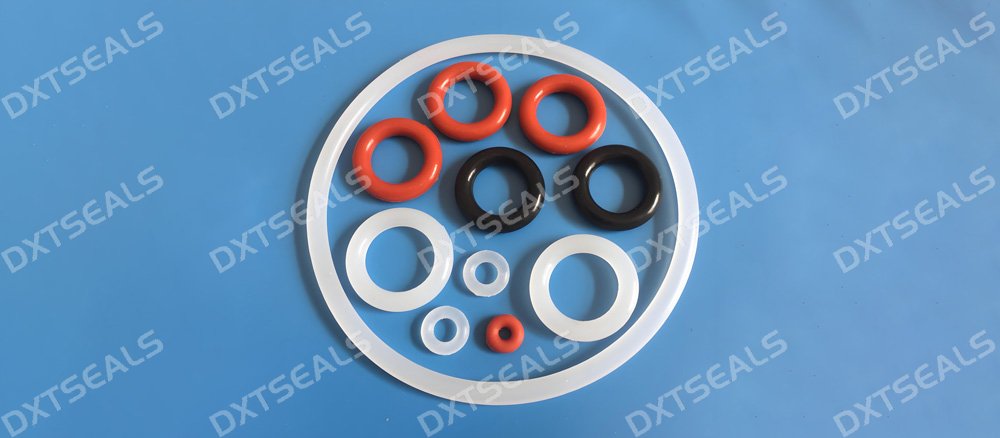
O-rings and gaskets are essential components in a wide range of industrial applications, providing reliable seals to prevent leaks, contamination, and other issues. However, the material used to manufacture these seals plays a crucial role in determining their performance and longevity. In this article, DXTSEALS will explore how material selection affects the effectiveness of O-rings and gaskets, and highlight key factors to consider when choosing the right materials for sealing solutions.
1. Understanding the Role of O-Rings and Gaskets
Before diving into material selection, it’s important to understand the role O-rings and gaskets play in industrial applications:
-
O-Rings: These are circular seals commonly used in machinery, engines, and hydraulic systems. They prevent leakage by creating a tight seal between two mating parts. O-rings are often used in applications that require dynamic sealing—where the seal is subjected to movement.
-
Gaskets: Gaskets are flat sealing components used to fill spaces between two surfaces. They are often used in static sealing applications, such as sealing flanges in piping systems or engine components, where there is no relative motion.
Both O-rings and gaskets are made from various materials, each offering specific benefits depending on the application requirements.
2. Key Factors Influencing Material Selection
The material used for O-rings and gaskets directly impacts their performance in various environments. The following factors should be considered when selecting materials:
a) Chemical Resistance
One of the most important factors in material selection is the chemical environment the seal will be exposed to. Different materials exhibit varying degrees of resistance to chemicals, oils, solvents, acids, and other substances. For example:
- Nitrile Rubber (NBR): Offers excellent resistance to petroleum-based oils and fuels.
- EPDM (Ethylene Propylene Diene Monomer): Highly resistant to water, steam, and polar solvents but not suitable for oils and fuels.
- Viton (FKM): Known for its excellent resistance to a broad range of chemicals, including acids, fuels, and solvents, making it ideal for harsh chemical environments.
Choosing a material that can withstand the specific chemicals in the application ensures a long-lasting and reliable seal.
b) Temperature Resistance
Another critical factor is the temperature range the material can handle. O-rings and gaskets may be subjected to extreme temperatures, either hot or cold, depending on the application. Materials with poor temperature tolerance may degrade quickly or lose their sealing properties. Consider the following materials for different temperature ranges:
- NBR: Best for moderate temperature ranges (approximately -40°C to 120°C).
- EPDM: Handles a wider range of temperatures, typically between -50°C and 150°C, making it suitable for both hot and cold environments.
- Viton: Offers superior high-temperature resistance, functioning well at temperatures up to 250°C, ideal for high-heat applications.
Selecting the right material ensures that the O-ring or gasket maintains its sealing performance under temperature fluctuations.
c) Mechanical Properties
The mechanical properties of the material, including its tensile strength, hardness, and compression set resistance, are critical for ensuring a tight, reliable seal under pressure. Materials with poor mechanical properties may lose their shape under compression, leading to leakage. For instance:
- NBR and Viton: These materials offer excellent mechanical strength, making them suitable for high-pressure applications.
- EPDM: While EPDM is flexible and resilient, it may not perform as well in applications requiring high tensile strength.
The ability of the material to withstand mechanical stresses is essential for applications where the seal will be subjected to high pressure or mechanical forces.
d) Compression Set Resistance
Compression set refers to the tendency of a material to deform permanently after being compressed. A high compression set can lead to leakage and seal failure over time. Materials with low compression set resistance maintain their shape and sealing effectiveness for longer periods.
- Viton: Offers excellent resistance to compression set, making it ideal for high-pressure and high-temperature applications.
- NBR: Generally performs well in moderate pressure environments, but may experience compression set in extreme conditions.
Choosing a material with low compression set resistance helps ensure that the O-ring or gasket will continue to perform effectively even after prolonged exposure to pressure.
3. Cost Considerations
While the performance of O-rings and gaskets is paramount, the cost of materials also plays a significant role in material selection. Some high-performance materials, such as Viton and FFKM, are more expensive but provide superior resistance to harsh chemicals and extreme temperatures. In contrast, materials like NBR and EPDM are more cost-effective and may be sufficient for less demanding applications.
Balancing material performance with cost-effectiveness is key to selecting the right O-ring or gasket material for your application.
4. Applications of O-Rings and Gaskets
The performance of O-rings and gaskets is highly dependent on the application they are used in. For example:
- Automotive: O-rings and gaskets in the automotive industry need to withstand high temperatures, oils, and fuel. Materials like NBR and Viton are commonly used in engines and fuel systems.
- Chemical Processing: In chemical processing plants, seals need to resist harsh chemicals and high temperatures. Viton and FFKM are often the best materials for these applications.
- Food and Beverage: In food processing, seals must meet stringent hygiene and safety standards. EPDM and Silicone O-rings are commonly used for their non-toxic and food-safe properties.
Choosing the right material ensures that the O-ring or gasket meets the demands of the specific industry.
5. Conclusion
Material selection is critical to the performance and reliability of O-rings and gaskets in industrial applications. Factors like chemical resistance, temperature tolerance, mechanical properties, and compression set resistance all play a role in ensuring the sealing component performs optimally. By understanding the specific requirements of your application and the advantages of different sealing materials, you can make an informed decision that ensures long-lasting and effective seals.
